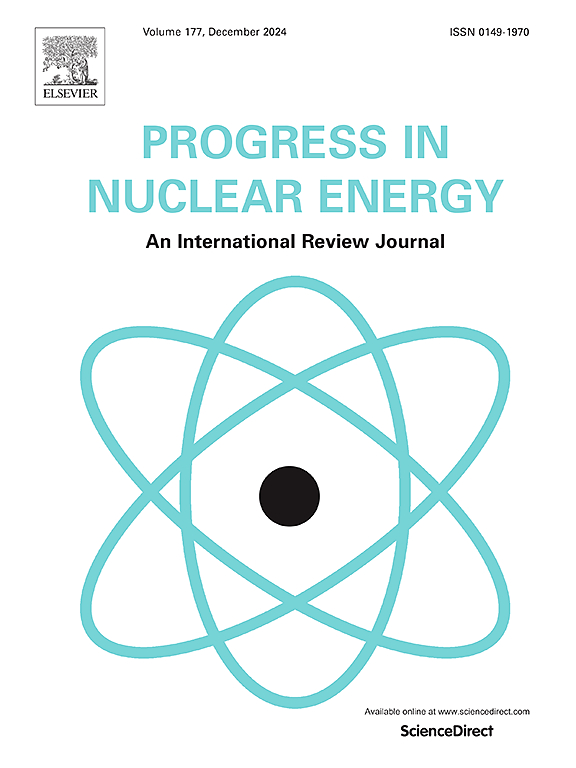中型池型SFR能量CDA下大两相燃料气泡演化的数值分析
IF 3.3
3区 工程技术
Q1 NUCLEAR SCIENCE & TECHNOLOGY
引用次数: 0
摘要
在钠快堆安全性分析中,含能堆芯破坏事故(CDA)下液钠池内的两相燃料气泡行为是一个必须考虑的问题。在高能CDA过程中,燃料气泡膨胀和由此产生的反应堆容器增压驱动了锕系元素从受损堆芯向覆盖气体区域的强化运输和液态钠向反应堆安全壳建筑(RCB)的释放。建立了考虑钠夹带和燃料-钠传热的中型池型SFR燃料气泡行为的数值模型。用相关的基准实验结果对模型进行了验证。在高能CDA条件下,燃料气泡质量一般在1000 ~ 3000 kg之间,初始燃料气泡温度在4200 ~ 4700 K之间。利用这些输入值进行参数化分析表明,气泡-池界面处的钠夹带量和燃料气泡行为对初始燃料气泡温度或过热的影响比对燃料气泡质量的影响更为敏感。燃料泡第一次膨胀-压缩循环的时间范围在600 - 800毫秒之间。在1000 kg-4200 K的情况下,绝热条件下(即没有钠夹带和燃料-钠传热)的平衡或准静压为1.57 × 105 Pa。在1000 kg ~ 4200 K条件下,考虑钠的夹带和燃料-钠的换热效应,钠蒸气分压占燃料总泡压的主导地位。结果,反应器容器内的准静压增加到3.0 × 105 Pa。燃料气泡-钠池界面速度历史决定了锕系元素从核心区向上位移,并将其评价为初始燃料气泡温度和质量的函数。考虑输入值的最大燃料气泡-钠池界面速度为35 ms−1。对气泡膨胀完成后反应堆容器压力历史的力学评价表明,辐射传热和燃料蒸气冷凝使反应堆容器压力在10 s内由准静态压力降至环境压力。评估的速度和压力历史将作为SFR中能量CDA情景下燃料气泡膨胀引起的容器内和安全壳事故源项的机制估计的输入。本文章由计算机程序翻译,如有差异,请以英文原文为准。
Numerical analysis of a large two phase fuel bubble evolution under energetic CDA in a medium-sized pool type SFR
The two-phase fuel bubble behavior inside the liquid sodium pool under energetic core disruptive accident (CDA) is an essential consideration in the safety analysis of sodium fast reactors (SFR). The fuel bubble expansion and the resultant reactor vessel pressurization during energetic CDA drive the enhanced actinide transport from the damaged core to the cover gas region and the liquid sodium release to the reactor containment building (RCB). A numerical model is developed to evaluate the fuel bubble behavior by considering the sodium entrainment and the fuel-sodium heat transfer in a medium-sized pool type SFR. The model is validated with relevant benchmark experimental results. Under energetic CDA conditions, the fuel bubble mass typically varies between 1000 and 3000 kg, and the initial fuel bubble temperature ranges from 4200 to 4700 K. The parametric analysis with these input values shows that the sodium entrainment at the bubble-pool interface and the fuel bubble behavior are more sensitive to the initial fuel bubble temperature or superheat than the fuel bubble mass. The time period for the fuel bubble's first expansion-compression cycle range between 600 and 800 ms. The equilibrium or quasi-static pressure under adiabatic condition (i.e. without sodium entrainment and fuel-sodium heat transfer) for the 1000 kg-4200 K case is 1.57 × 105 Pa. Results also show that the sodium vapor partial pressure dominates the total fuel bubble pressure in the 1000 kg-4200 K case when the sodium entrainment and the fuel-sodium heat transfer effects are included. As a result, the quasi-static pressure in the reactor vessel increases to 3.0 × 105 Pa. The fuel bubble-sodium pool interface velocity history which dictates the actinide upward displacement from the core region is evaluated as a function of initial fuel bubble temperature and mass. The maximum fuel bubble-sodium pool interface velocity for the input values considered is 35 ms−1. A mechanistic evaluation of the reactor vessel pressure history after the completion of bubble expansion shows that the radiation heat transfer and the fuel vapor condensation reduce the reactor vessel pressure from the quasi-static to the ambient pressure within 10 s. The evaluated velocity and pressure histories would serve as inputs for the mechanistic estimation of in-vessel and in-containment accident source terms due to the fuel bubble expansion under energetic CDA scenario in SFR.
求助全文
通过发布文献求助,成功后即可免费获取论文全文。
去求助
来源期刊

Progress in Nuclear Energy
工程技术-核科学技术
CiteScore
5.30
自引率
14.80%
发文量
331
审稿时长
3.5 months
期刊介绍:
Progress in Nuclear Energy is an international review journal covering all aspects of nuclear science and engineering. In keeping with the maturity of nuclear power, articles on safety, siting and environmental problems are encouraged, as are those associated with economics and fuel management. However, basic physics and engineering will remain an important aspect of the editorial policy. Articles published are either of a review nature or present new material in more depth. They are aimed at researchers and technically-oriented managers working in the nuclear energy field.
Please note the following:
1) PNE seeks high quality research papers which are medium to long in length. Short research papers should be submitted to the journal Annals in Nuclear Energy.
2) PNE reserves the right to reject papers which are based solely on routine application of computer codes used to produce reactor designs or explain existing reactor phenomena. Such papers, although worthy, are best left as laboratory reports whereas Progress in Nuclear Energy seeks papers of originality, which are archival in nature, in the fields of mathematical and experimental nuclear technology, including fission, fusion (blanket physics, radiation damage), safety, materials aspects, economics, etc.
3) Review papers, which may occasionally be invited, are particularly sought by the journal in these fields.
 求助内容:
求助内容: 应助结果提醒方式:
应助结果提醒方式:


